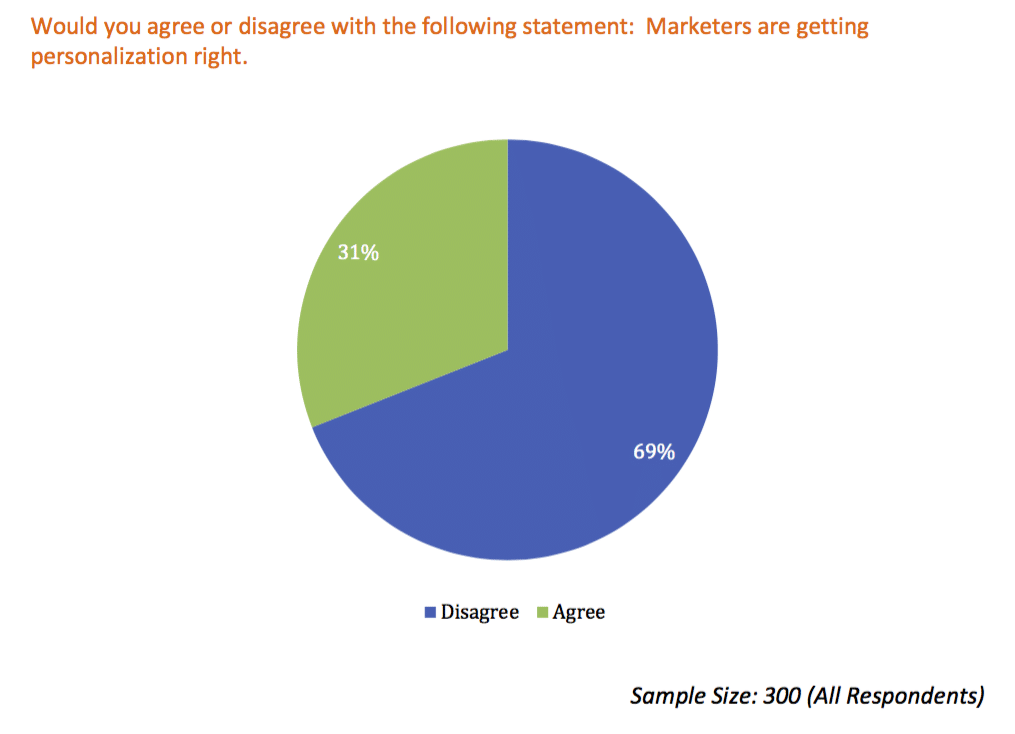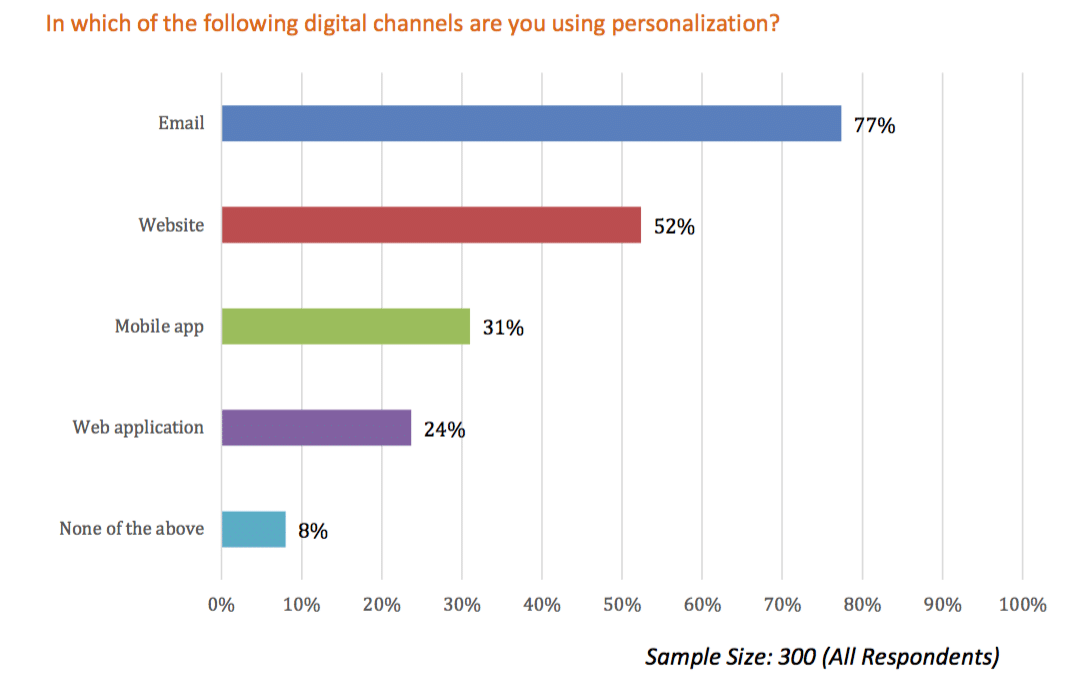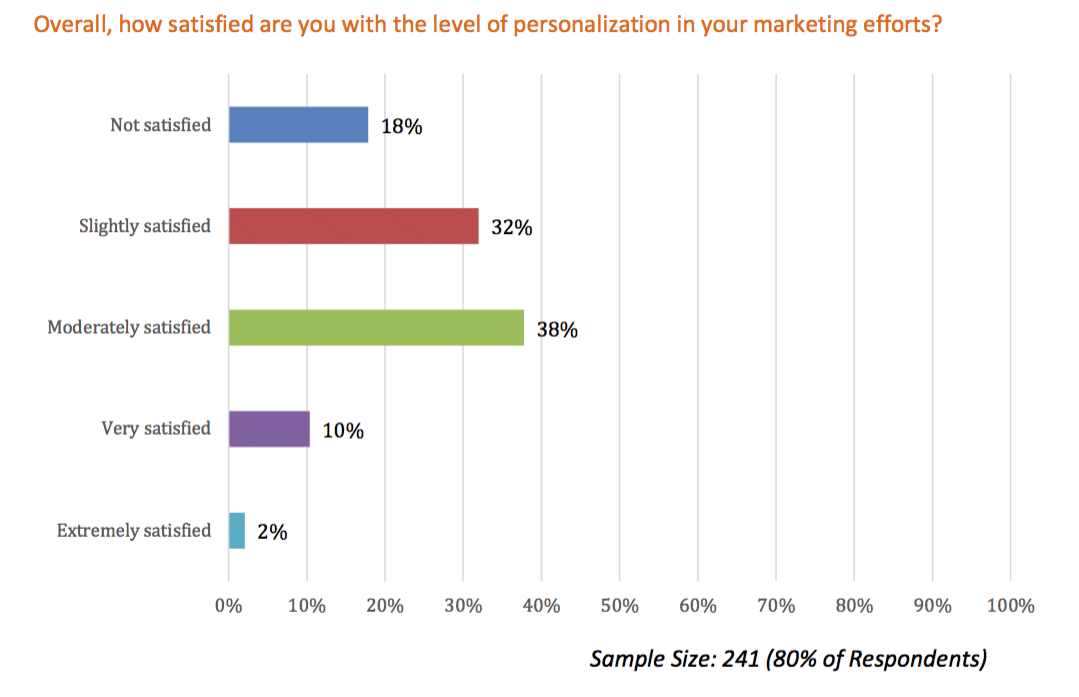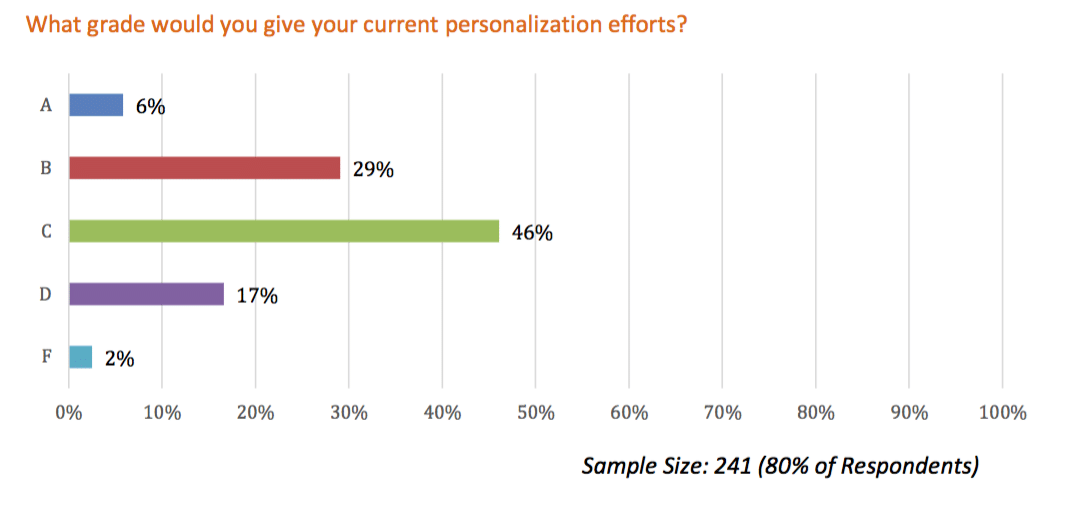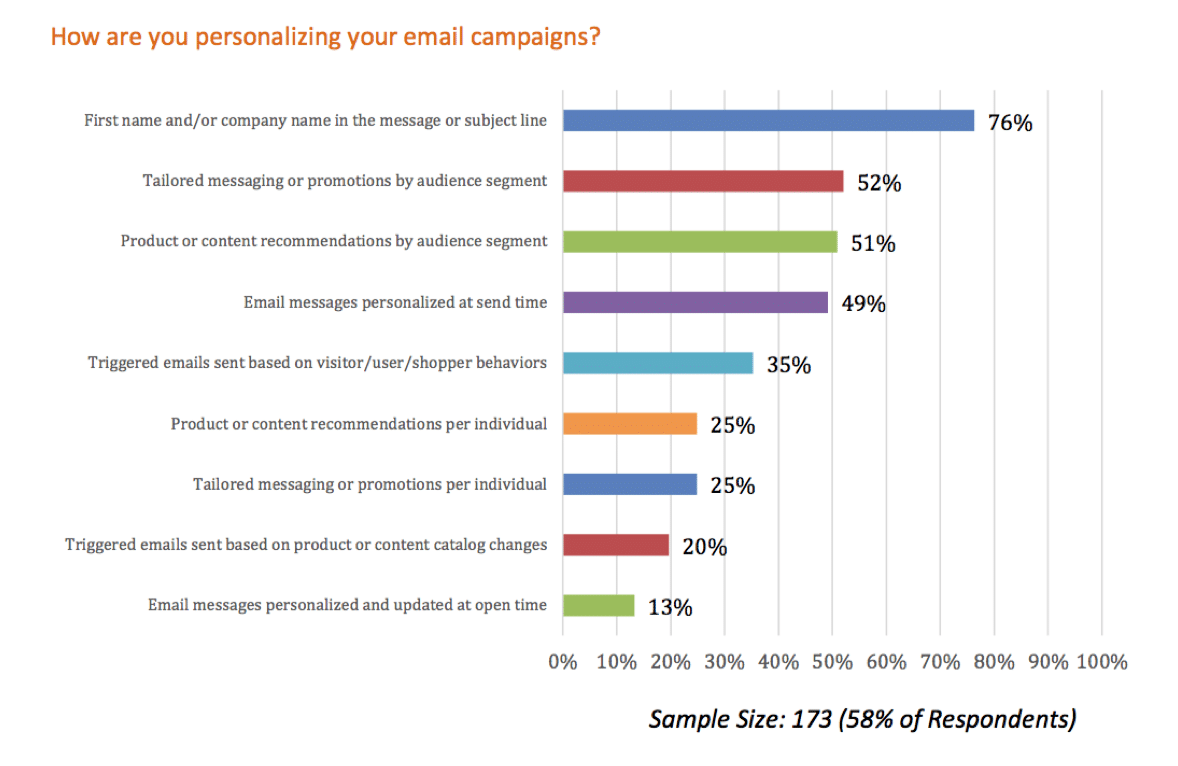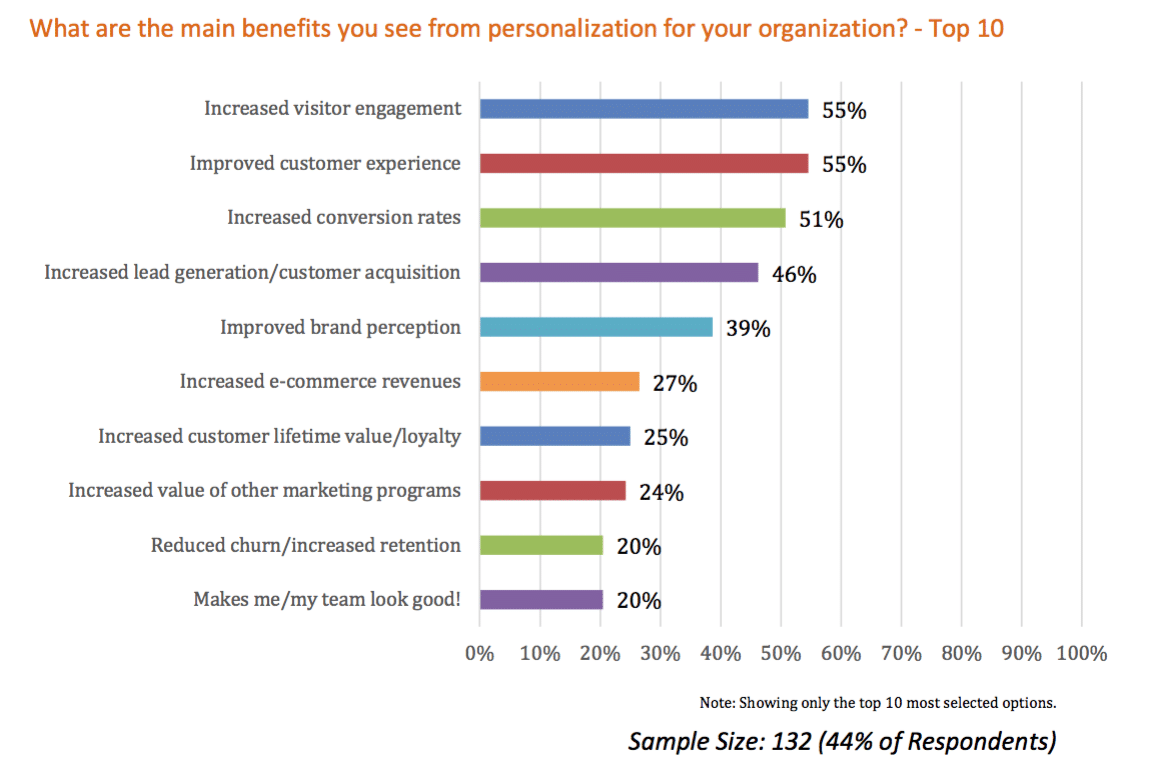New research finds that nearly 8 in 10 marketers (77 percent) think personalization should be a bigger priority in their organizations—but it’s clear that one size definitely doesn’t fit all, as marketers cite challenges in campaign execution in their efforts to foster one-to-one, in-the-moment experiences.
The newly released annual study from Evergage and Researchscape International, 2018 Trends in Personalization, explores new marketing approaches as customers across industries are demanding more helpful, relevant and individualized cross-channel experiences.
“Personalization has come a long way over the last decade—from delivering one-to-many experiences, aimed at broad groups of people, to being truly effective at the individual, one-to-one level,” said Evergage CMO Andy Zimmerman, in a news release.
“As buyers are increasingly exposed to effective forms of personalization, we’re reaching a tipping point—irrelevant, cookie-cutter experiences won’t cut it anymore,” he added. “People want to engage with companies that ‘know’ them and their preferences, and marketers need to deliver. The good news is that the knowledge, strategies and technology to make this happen are there, with cost barriers lower than ever.”
Personalization: The ultimate in customer-centricity
Services such as Netflix, Amazon and Spotify have set the bar in consumers’ minds for what personalized experiences should be. Customers are now increasingly looking for that type of treatment—not just in their personal interactions, but across their business interactions as well. In fact, nearly nine of out 10 marketers surveyed (88 percent) say their customers expect experiences, across channels, that are individualized to them.
In addition, nearly all marketers (98 percent) agree that personalization positively impacts customer relationships, with 3 out of 4 (74 percent) describing that impact as “strong” or “extremely strong.” Marketers cited benefits achieved from their personalization campaigns, including measurable lift in business results (87 percent), with more than half of marketers citing a lift greater than 10 percent.
Three principal areas of benefits marketers experience include:
- Increased visitor engagement (55 percent)
- Improved customer experience (55 percent)
- Increased conversion rates (51 percent)
As more organizations seek to connect more deeply with their customers and realize these benefits, they’re increasing their investments in personalization. More than 1 in 3 marketers (37 percent) say their personalization budget will increase next year (60 percent note it will remain the same).
Challenges encountered
Despite recognizing and realizing substantial benefits, many marketers feel their personalization efforts are just scratching the surface. They see more that can be done to make personalization more pervasive and effective, and think there’s opportunity for improvements—both at their own companies and at large. For example, 65 percent of marketers give their company’s personalization efforts a “C” grade or below, and just more than 1 in 10 marketers (12 percent) are “very” or “extremely” satisfied with the level of personalization in their company’s marketing efforts (38 percent are moderately satisfied).
In addition, nearly 7 in 10 marketers (69 percent) think the industry isn’t getting personalization right—a sentiment more pronounced within large companies (83 percent of marketers at organizations with $1 billion or more, compared to 63 percent of marketers at smaller organizations). That’s not to say they’re disillusioned, though, since larger organizations are investing or planning to invest more in personalization.
Some of these hindrances experienced may stem from data challenges. For example:
- Garbage in, garbage out: More than half of marketers (55 percent) say they don’t have sufficient data and insights to drive effective personalization. Marketers at B2B companies feel this challenge more deeply (58 percent at B2B companies; 39 percent at B2Cs; 60 percent at companies that define themselves as both B2B and B2C).
- More data difficulties: Nearly 1 in 3 marketers say that low-quality data (31 percent) and difficult access to data (31 percent) impede personalization from being a bigger priority in their organizations. Other top challenges cited include lack of budget (51 percent), lack of personnel (49 percent), and lack of knowledge/skills (40 percent).
- Data sprawl: Nearly 7 in 10 marketers (69 percent) say their customer data is stored in three or more systems. Marketers are also drawing on (often simultaneously) multiple tools and “point solutions” to execute personalization campaigns—including email personalization tools (64 percent), A/B testing (55 percent), triggered email solutions (36 percent), recommendations engines (17 percent), personalized search tools (8 percent) and more. Just more than a quarter of marketers (26 percent) currently use a personalization platform, which can encompass all these functions, while centrally storing and processing customer data.
- Limited cross-channel visibility: Many organizations can’t connect the dots across channels, as they’re unable to access and act on data that shows a customer’s journey from one touchpoint to the next. In fact, 73 percent of marketers say their company has just a few—or no—channels connected.
All of this may explain why more than half of marketers surveyed (56 percent) describe their organization’s personalization maturity as “limited” at best. Only 11 percent think their company delivers “advanced” or “best-in-class” personalization.
“Bad data means bad personalization—which isn’t really personalization at all,” Zimmerman said. “Finding the right data sources and technology partners may not be glamorous, but it’s critical to an effective personalization program. To demonstrate you truly understand each and every customer and prospect, your data must be accurate, real-time, deep, behavioral, contextual, centralized, and able to be interpreted and maintained at the individual level.”
Types of usage
Marketers reported on the various ways they’re applying personalization, including:
- Channels employed: Digital marketers today use personalization in email (77 percent), on their websites (52 percent), in their mobile apps (31 percent) and in their web apps (24 percent).
- Criteria used: Marketers report personalizing based on an online visitor’s campaign source (43 percent), location (39 percent), demographics (37 percent), products purchased (36 percent), clicks (33 percent), pages/content viewed (32 percent) and company (27 percent). Only 12 percent factor in a visitor’s engaged time on a page—shown to be a highly accurate reflection of visitor interest.
- Focus on email: Marketers personalize their email campaigns by first name and/or company name in the message or subject line (76 percent), tailored messages or promotions by audience segment (52 percent) and product or content recommendations by audience segment (51 percent). Nearly half of marketers (49 percent) say their messages are personalized at send-time, while only 13 percent deploy open-time personalization (enabling content to update in real time based on the person’s up-to-the-moment behavior or catalog changes). More than 1 in 3 marketers (35 percent) trigger emails based on a visitor’s behavior, and a quarter (25 percent) tailor their product and content recommendations at the individual level.
- Machine learning: More than 1 in 4 marketers (26 percent) say they employ machine-learning-driven personalization: that is, using algorithms and predictive analytics to dynamically present recommendations and experiences at the individual level. Among those not yet using machine learning, 41 percent of marketers say they plan to do so within the next year (26 percent at B2B organizations; 55 percent at B2C organizations; 49 percent at organizations that are both B2B and B2C).
“Machine learning and AI have redefined the nature, speed and degree to which we can deliver personalization in recent years,” said Karl Wirth, Evergage co-founder and CEO, and author of the book, One to One Personalization in the Age of Machine Learning, in the release. “They’ve made personalization possible at the individual level, in real time and at scale. Think about it: one well-tuned machine-learning algorithm can do the work of thousands of previous manual rules – saving marketers time, and delivering and acting on insights that foster greater customer loyalty and engagement.”
Evergage enlisted Researchscape International to help survey 300 marketing professionals at organizations of all sizes about their usage of and plans with personalization. Respondents came from a range of industries and held a variety of marketing and/or senior-management titles. While the majority of responses came from the United States, the study includes the viewpoints of respondents from four other countries (Canada, Germany, India and the United Kingdom). Researchscape used an online survey, fielded between Feb. 22 and March 28, 2018, and the results were not weighted.


